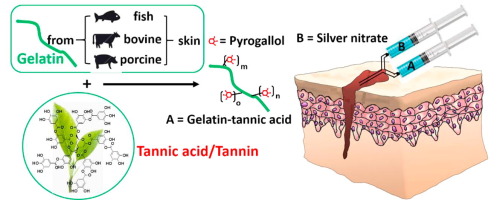Acta Biomaterialia ( IF 9.4 ) Pub Date : 2018-03-17 , DOI: 10.1016/j.actbio.2018.03.008 Jinshan Guo 1 , Wei Sun 2 , Jimin Peter Kim 1 , Xili Lu 3 , Qiyao Li 1 , Min Lin 4 , Oliver Mrowczynski 5 , Elias B Rizk 5 , Juange Cheng 2 , Guoying Qian 6 , Jian Yang 1

|
Tissue adhesives play an important role in surgery to close wounds, seal tissues, and stop bleeding, but existing adhesives are costly, cytotoxic, or bond weakly to tissue. Inspired by the water-resistant adhesion of plant-derived tannins, we herein report a new family of bioadhesives derived from a facile, one-step Michael addition of tannic acid and gelatin under oxidizing conditions and crosslinked by silver nitrate. The oxidized polyphenol groups of tannic acid enable wet tissue adhesion through catecholamine-like chemistry, while both tannic acid and silver nanoparticles reduced from silver nitrate provide antimicrobial sources inherent within the polymeric network. These tannin-inspired gelatin bioadhesives are low-cost and readily scalable and eliminate the concerns of potential neurological effect brought by mussel-inspired strategy due to the inclusion of dopamine; variations in gelatin source (fish, bovine, or porcine) and monomer feeding ratios resulted in tunable gelation times (36 s to 8 min), controllable degradation (up to 100% degradation within a month), considerable wet tissue adhesion strengths (up to 3.7 times to that of fibrin glue), excellent cytocompatibility, as well as antibacterial and antifungal properties. The innate properties of tannic acid as a natural phenolic crosslinker, molecular glue, and antimicrobial agent warrant a unique and significant approach to bioadhesive design.
Statement of Significance
This manuscript describes the development of a new family of tannin-inspired antimicrobial bioadhesives derived from a facile, one-step Michael addition of tannic acid and gelatin under oxidizing conditions and crosslinked by silver nitrate. Our strategy is new and can be easily extended to other polymer systems, low-cost and readily scalable, and eliminate the concerns of potential neurological effect brought by mussel-inspired strategy due to the inclusion of dopamine.
The tannin-inspired gelatin bioadhesives hold great promise for a number of applications in wound closure, tissue sealant, hemostasis, antimicrobial and cell/drug delivery, and would be interested to the readers from biomaterials, tissue engineering, and drug delivery area.
中文翻译:

单宁抗菌生物粘合剂的开发
组织粘合剂在闭合伤口、密封组织和止血的手术中发挥着重要作用,但现有的粘合剂价格昂贵、有细胞毒性或与组织的粘合力弱。受植物源单宁的防水粘附力的启发,我们在此报告了一种新的生物粘合剂家族,其源自单宁酸和明胶在氧化条件下轻松、一步的迈克尔加成反应,并通过硝酸银交联。单宁酸的氧化多酚基团通过类儿茶酚胺化学作用使湿组织粘附,而单宁酸和硝酸银还原的银纳米颗粒都提供了聚合物网络内固有的抗菌源。这些受单宁启发的明胶生物粘合剂成本低且易于扩展,并且消除了由于包含多巴胺而受贻贝启发的策略带来的潜在神经效应的担忧;明胶来源(鱼、牛或猪)和单体饲喂比例的变化导致胶凝时间可调(36 秒至 8 分钟)、可控降解(一个月内降解高达 100%)、相当大的湿组织粘附强度(高达是纤维蛋白胶的3.7倍),具有优良的细胞相容性,以及抗菌、抗真菌性能。单宁酸作为天然酚醛交联剂、分子胶和抗菌剂的固有特性保证了生物粘合剂设计的独特而重要的方法。
重要性声明
该手稿描述了一种新的单宁抗菌生物粘合剂系列的开发,该粘合剂源自单宁酸和明胶在氧化条件下轻松、一步的迈克尔加成反应,并通过硝酸银交联。我们的策略是新颖的,可以很容易地扩展到其他聚合物系统,成本低且易于扩展,并且消除了由于包含多巴胺而受到贻贝启发的策略带来的潜在神经效应的担忧。
受单宁启发的明胶生物粘合剂在伤口闭合、组织密封剂、止血、抗菌和细胞/药物输送方面具有广阔的应用前景,并且会引起生物材料、组织工程和药物输送领域的读者的兴趣。









































 京公网安备 11010802027423号
京公网安备 11010802027423号